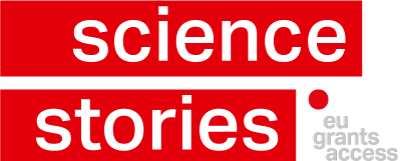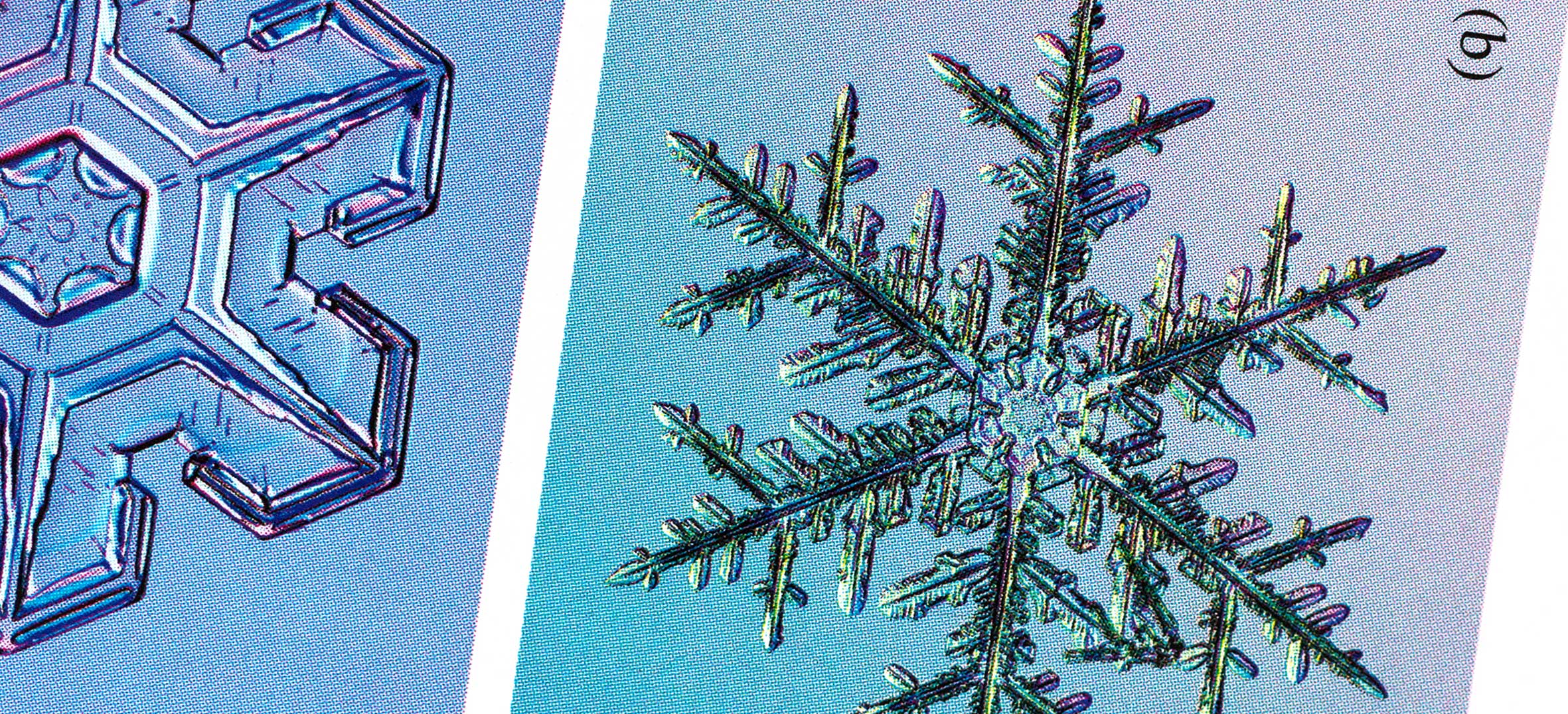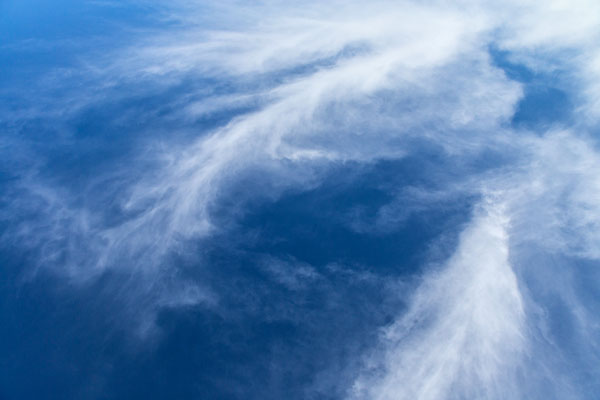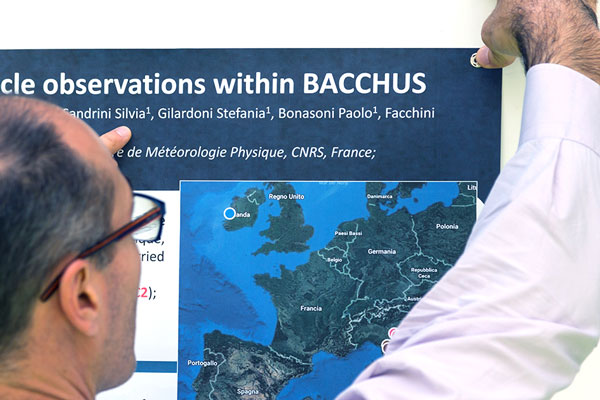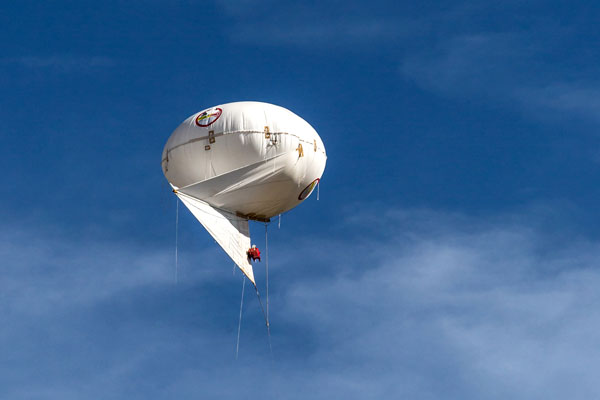«The database on ice nucleating particles is at the heart of our joint research»
Ulrike Lohmann analyses the formation and development of clouds as well as the interaction between them and climate. Together with her project manager, Monika Burkert, she just finished an EU project involving 21 partners.
The media call her the «cloud lady». The real name for what she does is by far less poetic: Ulrike Lohmann is a Professor for Experimental Atmospheric Physics at ETH Zurich. Her research focuses on the formation and development of clouds as well as on the interaction between them and climate. Unsurprisingly, the researcher’s office is located somewhat nearer to the clouds than others: from the ninth floor of an ETH Zurich building, she has a spectacular view over Zurich West. Three floors above her is the rooftop terrace, from which she can observe the weather and cloud formations. However, Ulrike Lohmann likes it best even higher up. She loves to watch the clouds beneath her: «A sea of clouds with blue sky above is the most beautiful scenery ever,» she says.
A layperson looks for faces, animals or fantasy sculptures when watching the clouds; Ulrike Lohmann, the scientist, looks deeply into the clouds. She searches for particles – since cloud droplets and ice crystals need aerosol particles as seeds. The dark thundercloud, the fleecy clouds floating in the sky like tiny cotton balls or the impressively twisted cumulus clouds: They all consist of cloud droplets, ice crystals or both.
«I have never been asked
to participate in so many
EU projects as right now.»
Ulrike Lohmann is interested in the ice crystals and what is inside them. Ice crystals can only form with the help of a grain of sand from the Sahara, a soot particle, a pollen grain or an organic particle from the ocean to which they can attach themselves. As we usually live way below the clouds, we become aware of the fact that they consist of water and particles only when the media announce «blood rain», as they did for 13 April 2018; when the clouds rain down on us in various colours: red (Saharan dust), yellow (pollen) or black (soot).
Aerosol particles influence the climate system
These so-called aerosol particles acting as centres for ice crystals hover in our atmosphere and, despite their small size, have a major influence on the formation of clouds, their thickness and phase as well as on the quality of the air that we breathe (particulate matter, smog). Aerosol particles also have an effect on the climate. Some particles contribute to the global warming as they absorb radiation similar to greenhouse gases. Others contribute to the global cooling as they reflect parts of the sunlight back to space similar to a parasol; by this, less solar energy reaches the surface of the earth. Some aerosol particles also destroy stratospheric ozone. «Once we get a deeper understanding of how aerosol particles are related to the formation of ice clouds, we will also be able to unravel some reasons behind climate change and precipitation formation,» Ulrike Lohmann explains.
EU funding for basic research
For almost 20 years, Ulrike Lohmann has pondered on how and why ice crystals are formed. «I realised early on that we know very little about ice clouds and have therefore started my own experimental group.» Ulrike Lohmann is considered a pioneer in the field of ice crystal modelling within the climate model.
For the past four and a half years, she has been the coordinator of an EU project on the formation of ice clouds, involving 21 partners. «Roughly 15 percent of the resources awarded went to our institute; this enabled us to accelerate our own research,» the ETH researcher says. The EU project is worth 8.7 million € and is called BACCHUS. One of its goals is to set up an Open Access Database with international ice nucleating particle measurements so that users eventually will be able to search for detailed aspects of these measurements and will be able to find possible linked complementary measurements. «We finally want to amalgamate the knowledge gathered,» Ulrike Lohmann states. Another goal was to get a deeper understanding of the interaction between aerosol particles, clouds and climate in order to achieve better projections for future climate and establish improved principles for a sustainable climate policy within Europe. One of the issues raised thereby was to study the effect from natural aerosol particles (such as pollen, algae, salt, etc.) versus those produced by humankind (such as soot, fine particulates, etc.) on cloud formation and climate. The BACCHUS project had Ulrike Lohmann and her team also dealing with how the cloud formation in the Arctic will be influenced should maritime traffic increase due to the melting of ice. Ships emit soot particles as well as CO2.
It was the first EU project that Ulrike Lohmann headed herself. The FP7 project has just been completed. The final meeting was held at ETH Zurich at the end of April 2018. For the last time, the project participants from 13 different countries presented their results by means of lectures and a poster session. The around 50 attendants discussed climate models, measurement data and methods. The discussions were engaged in a somewhat familiar atmosphere. «Indeed, we have achieved good relationships with the partners over the course of these four and a half years,» Ulrike Lohmann recounts. She, too, enjoyed the open dialogue. «This is something you can never take for granted, with so many different personalities involved.»
Career-promoting project management
Monika Burkert, sitting next to her in the office with a view, nods in approval. She was involved the most with said personalities. Monika Burkert organised and held together the BACCHUS project as a project manager. «I quickly learned to treat the different characters with different approaches,» she laughs.
A project involving this many international partners requires a tight project management. Monika Burkert joined the project halfway through, after her predecessor was promoted Executive Director of the Center for Climate Systems Modelling at ETH Zurich. «Project management obviously enhances your career-promoting skills,» Ulrike Lohmann states delightedly. The predecessor’s management experience with BACCHUS was one of the reasons why she was appointed to her new executive function. Monika Burkert filled in as her successor and brought along the necessary skills: She holds a PhD in Atmospheric Physics and works in Lohmann’s group. She is one of those scientists who enjoys «dealing with details of ice nucleating particles in the laboratory,» she says.
«Roughly 15 percent of
the resources awarded
went to our institute;
this enabled us to
accelerate our own
research.»
Her passion for detail, her accuracy and the fact that she enjoys interacting with people proved highly advantageous for the project management tasks. When she listed all of the management activities during the final meeting of the BACCHUS group, the crowd was getting rather dizzy. She organised all the meetings, workshops and participations of the group at international conferences. For a while, she maintained the ice nucleating particle database herself. She ensured that the group’s members published their results: at the time of the final meeting, the BACCHUS group had already published 120 peer-reviewed papers. The project manager organised advanced training for young scientists, was responsible for media presence and the BACCHUS website. She provided the European Commission with reports and made sure that the gender balance improved noticeably (30 percent of the project participants were female). And this just lists a few of her many responsibilities. She was the contact point for all 21 partners.
How did she manage to do it all? Monika Burkert knows the secret – the coaching of EU GrantsAccess. «They supported me proficiently. Whenever I needed counselling, the information and advice office of the University of Zurich and ETH Zurich was there to help swiftly with their profound experience in international research projects. For example, they could tell me in detail what to do in terms of scientific, administrative and financial reporting.»
However, professional knowledge is not the only asset that facilitates the management of such a large project: you also need personal skills. «The main thing is to quickly get to know the project participants. Knowing each other makes everything easier,» Monika Burkert says. Reminding people was her most difficult task. Certain project participants had to be reminded repeatedly of deadlines. Others did not read emails properly and had to be reminded regularly of the publication policy. «I then had to pick up the phone,» the project manager recounts. «At any rate, I certainly massively enhanced my multitasking skills during this project.»
Attracting the attention of the scientific community
Coordinating a European project with 21 partners is very demanding – yet, the project certainly had enormous benefits, Ulrike Lohmann says. Not only that her research group received funds for their research, they also strengthened and enlarged their network, the PhD candidates and postdocs were able to acquire experiences in an international project and establish contacts themselves. The BACCHUS group also attracted the attention of the scientific community, as, for example, they had their special session at the annual conference of the European Geosciences Union in 2016 and because the project participants published continuously. «I have never been asked to participate in as many EU projects as right now,» Lohmann says. The project also produced new or enhanced collaborations spontaneously, for example a joint measurement campaign on Cyprus and in Ireland: The clouds over Cyprus often form on Saharan dust, whereas in Ireland marine and continental clouds forming on various aerosol particles can be observed. «This collaboration opens doors to new possibilities.»
«The main thing is
to quickly get to know
the project participants.
Knowing each other
makes everything much
easier.»
The BACCHUS project had focused on mixed-phase clouds containing water and ice. It examined clouds up to an altitude of 3.5 kilometres. Ice nucleating particle measurements were taken on the Jungfraujoch, captive balloons and cable cars with holographic cameras and so-called skywalkers were sent into the clouds in various countries and one group brought measurement data back from an ocean research cruise, which took them from Bremerhaven to Cape Town with side trips to the Antarctic and back home. The database has been filled with ice nucleating particle measurements from the partners, yet it is not complete. «The main thing is that the database is set up and will continue to be enlarged even when the BACHHUS project is completed,» Ulrike Lohmann states. She is very happy that the long-awaited database is finally a reality. «It is at the heart of the international collaboration.»
Reducing «aggressive» CO2 and air polluting emissions
Of course, the EU project could not conclusively answer the question raised concerning the interaction between aerosol particles, the formation of clouds and climate. The research conducted in the Arctic showed, roughly summarised, that the emissions of increased ship traffic within the area are less important for the changes in Arctic clouds than the augmented evaporation of an ocean free of ice: the latter creates thicker clouds.
According to Ulrike Lohmann, the impact of aerosol particles from human activities on ice clouds is smaller than assumed. Earlier studies had shown that clouds forming on anthropogenic particles reduced the greenhouse effect by 30 percent; the warming of the earth’s atmosphere would have been even higher without them. However, this does not mean that humanity can continue as previously done, because the pollution of the air has a strong impact on people’s health around the world. «These findings show that we have to reduce CO2 emissions and air pollution simultaneously and even more aggressively than before. There is simply no alternative.»
Interview with Ulrike Lohmann
Ulrike Lohmann
Since October 2004, Ulrike Lohmann is a Professor for Experimental Atmospheric Physics at the Institute for Atmospheric and Climate Science of ETH Zurich. Born in Berlin, she studied Meteorology at the Universities of Mainz and Hamburg. In 1996, she obtained her PhD in Climate Modelling from the Max Planck Institute for Meteorology. She was a postdoctoral fellow at the Canadian Centre for Climate Modelling and Analysis in Victoria and an Assistant and Associate Professor at Dalhousie University in Halifax. She was awarded a Canada Research Chair in 2002, received the AMS Henry G. Houghton Award in 2007 and was elected as a fellow of the American Geophysical Union in 2008 and of the German National Academy of Sciences, Leopoldina, in 2014. Ulrike Lohmann has published more than 200 peer-reviewed articles. She was a lead author for the Fourth and Fifth Assessment Reports of the Intergovernmental Panel for Climate Change (IPCC), who received the Nobel Peace Prize. The award, which she received as an IPCC member, is hanging in her office.
Ulrike Lohmann is contributing to the following EU-funded projects
Projects funded by FP7
«BACCHUS – Impact of Biogenic versus Anthropogenic emissions on Clouds and Climate:
towards a Holistic UnderStanding», collaborative project
Duration: 2013-2018
Coordinator: ETH Zurich, Switzerland
Partners: 21 research institutions from 13 different EU countries
Financial contribution from FP7: 8,746,587 € (1,391,044 € for ETH Zurich)
«DACCIWA – Dynamics-Aerosol-Chemistry-Cloud Interactions in West Africa», collaborative project
Duration: 2013-2018
Coordinator: Karlsruhe Institute of Technology, Germany
Partners: 16 institutions from 6 different countries
Financial contribution from FP7: 8,746,982 € (340,200 € for ETH Zurich)
Projects funded by Horizon 2020
«ATM-METFIN – Quantifying atmospheric ice nucleating particle (INP) concentrations via advances
in measurement techniques and field studies of ice nucleation»
Marie Skłodowska-Curie Actions: Individual Fellowship
Duration: 2017-2019
Financial contribution from H2020: 175,418 €
